Are consumers ready for AI?
A world where we would use AI to do mundane tasks like shopping or cooking no longer sounds like something out of a sci-fi book. In 2024, Wendy’s has been testing AI-powered drive-thrus while Instacart is gearing up AI-fueled smart carts. Technology brands like Apple are already changing how we interact with virtual reality daily – who knows what Vision Pro might look like if we add AI!
But are consumers ready for that? Would they be willing to use new technology for mundane food & beverage experiences like cooking and grocery shopping? And what technology are they most open to adopting today?
To answer these questions, we conducted an Upsiide study with Americans on their food & beverage consumption habits. As part of the study, we asked respondents to tell us more about tasks they try to accomplish when cooking and grocery shopping. Then, we showed them a range of AI technologies that could help them do those tasks quicker, easier or more efficiently. The idea was to understand which AI technologies consumers are most willing to try in the near future.
Psst! We’ve got a handy report with more insights about AI and food & beverage consumption in America. Access it right now!
Why we turned to Jobs to be Done (and what it is)
Understanding customer tasks was the perfect opportunity for us to use the Jobs to be Done framework.
JTBD is a framework that is driven by one phenomenon – people are inherently looking for ways to improve themselves. People then “hire” a brand or product to help them achieve that goal (or fulfill a “job”). Brands can use the JTBD framework to truly understand what customer needs or pain points their product should solve.
We asked consumers to share what tasks they find important in cooking and grocery shopping and how satisfied they are with achieving them. We then used those metrics to plot them out on a JTBD quadrant chart. Each quadrant has a name:
- Delighters – tasks in this quadrant are high in importance and high in satisfaction. Consumers prioritize these tasks when shopping/cooking and think they can fulfill them well.
- Necessary – these tasks are very important to consumers, but they aren’t satisfied with them. Tasks in this quadrant can be the low-hanging fruit for brands to solve.
- Opportunities – tasks in this quadrant aren’t that important to consumers, but they still find them satisfying. Brands can use tasks in this quadrant to differentiate from their competitors.
- Low yield – these tasks aren’t high on importance or satisfaction.
Jobs to Be Done in Cooking
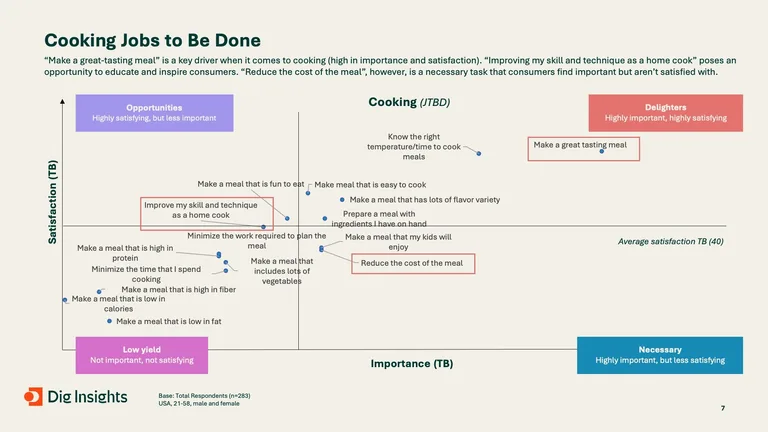
“Making a great tasting meal” is a clear Delighter – i.e. Americans find this task important and are satisfied with it. If we look closer at the average results, we might find tasks related to making tasty meals – e.g., “make a meal that has lots of flavour variety” or “prepare a meal with ingredients I have on hand.”
Reducing the cost of the meal is a necessary task. American consumers feel they need more affordable options – a trend we noticed throughout our study. “Make a meal that my kids will enjoy” is probably most relatable to parents.
In the Opportunities quadrant, we have tasks that consumers prioritize less but are pretty satisfied with – e.g. “improving my skill and technique as a home cook.”
Overall, these tasks can be read holistically. For example, American consumers might want to improve their cooking skills because they don’t go out much and want to save money.
Jobs to be Done in Grocery Shopping
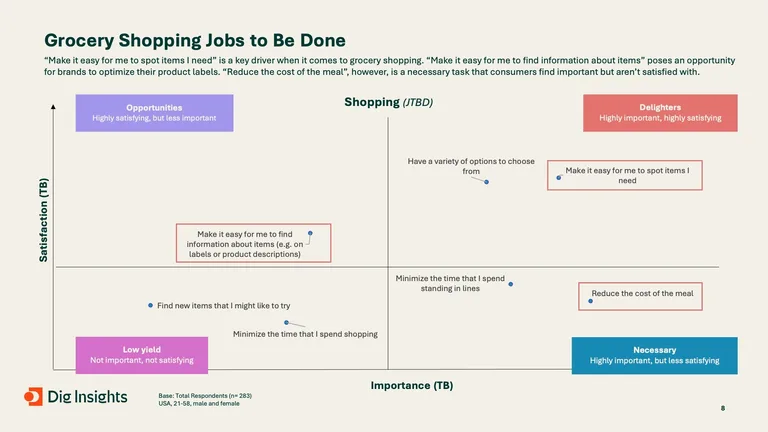
Consumers are delighted with their ability to “easily spot items they need”, a highly important and satisfactory task. They also are pretty satisfied with their ability to find “a variety of options to choose from” at grocery stores.
However, just like with cooking, “reducing the cost of the meal” is very important to them, but they aren’t satisfied with their ability to do so. Saving time is another necessary task they are less happy with fulfilling.
“Making it easy for me to find information about items” could potentially create an opportunity for brands to update their labels and packaging descriptions. There are already apps that help customers check items for allergens or toxins, making it easier to eat safely.
So, which AI tech could fulfill these jobs?
We conducted a screening exercise in which American consumers saw a range of new technologies that can enhance their cooking and grocery shopping experiences. Interestingly, the AI-powered technologies in the survey were generated by our Upsiide AI Idea Generator.
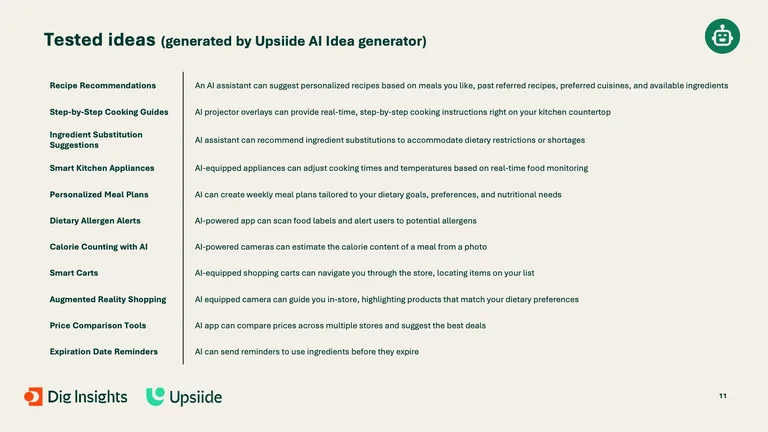
If a consumer liked a technology, they swiped right. If they didn’t like it, they swiped left. If they swiped right on 2 technologies, they were prompted to pick a favorite; mimicking real shopping behavior and trade-offs.
Let’s have a look at the results!
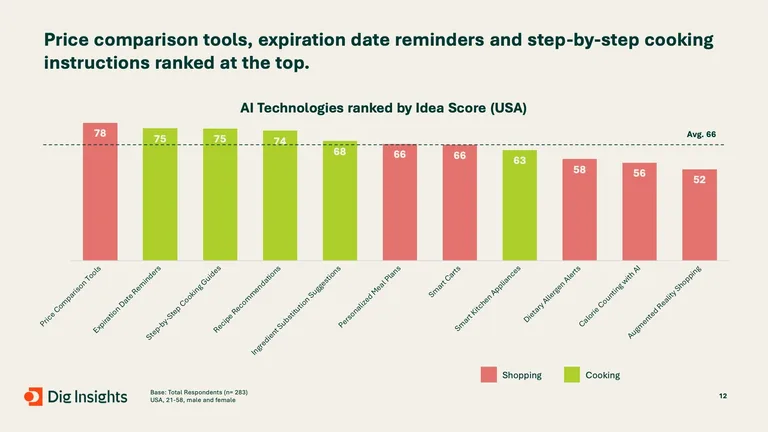
Jobs related to “reducing the cost of the meal” came to the top: Price comparison tools and Expiration date reminders were the strongest performers. Step-by-step cooking guidees came third, indicating the connection to jobs like “making a great tasting meal” or “improving my skill and technique as a home cook.”
Ideas like Personalized meal plans and Smart carts have an average popularity rate, but they still fulfill jobs like “making a great tasting meal” or “making it easy to spot items I need.”
Ideas that fall at the bottom are “Augmented reality shopping” and Calorie counting with AI.” It doesn’t mean that these ideas don’t have much power – it’s just that in comparison to other tech, they weren’t as popular.
The most impactful AI technologies, in our opinion
Looking at the rankings in the previous sections, we noticed that some of the popular AI tech in our study is slowly appearing (e.g. Samsung is pioneering smart kitchen appliances). However, we wanted to see which AI technologies could have the most impact.
Our VP of Insights and CPG expert, Samantha Muscia, outlined 3 AI technologies from our list that can be the most impactful in the near future and how retailers, brands or third-party organizations can harness them.
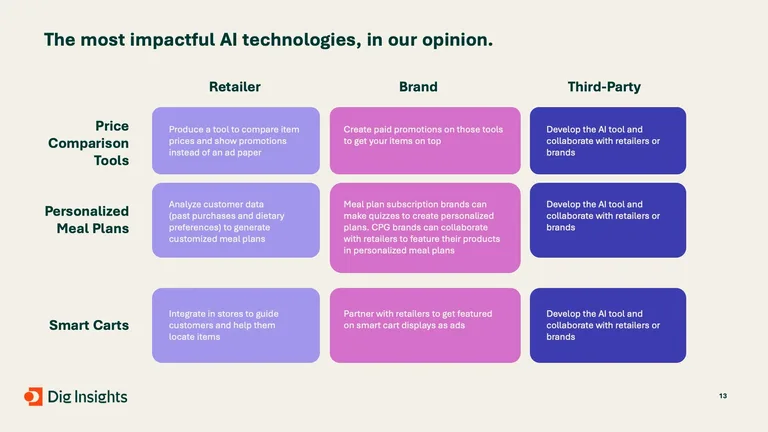
Price Comparison Tools
- Retailers can develop their own price comparison tool integrated into their website or mobile app. They can leverage AI algorithms to continuously scan prices at various retailers and update their database in real-time. By allowing consumers to compare prices conveniently, retailers can attract more customers and enhance their shopping experience.
- Brands can collaborate with retailers to integrate their products into the retailer’s price comparison tool and do paid promotions to get their items to the top of the list (like Amazon-promoted ads).
- Third-party companies specializing in price comparison technology can develop standalone apps or browser extensions. These tools can aggregate pricing data from various retailers and offer users a comprehensive view of product prices. Third-party companies can generate revenue through partnerships with retailers or by offering premium features to users for a fee.
Personalized Meal Plans
- Retailers can analyze customer data, including past purchases and dietary preferences, to generate customized meal plans tailored to individual needs. Retailers can also integrate their meal planning tools with their online grocery delivery services to offer a seamless shopping experience.
- Brands can collaborate with retailers to feature their products in personalized meal plans. Brands can also sponsor or co-create meal-planning content with retailers to promote their products effectively.
- Third-party companies can develop standalone meal-planning apps or platforms. They can partner with retailers and CPG brands to integrate their products and services into their meal-planning platforms.
Smart Carts
- Retailers can invest in developing AI-equipped shopping carts that are integrated with their store’s layout and inventory system. These smart carts can guide customers through the store, helping them locate items on their shopping list efficiently.
- Brands can partner with retailers to feature their products prominently within smart carts.
- Third-party companies can develop and supply AI-equipped shopping carts to retailers. They can also provide ongoing support and maintenance services to ensure the smooth operation of the smart carts.